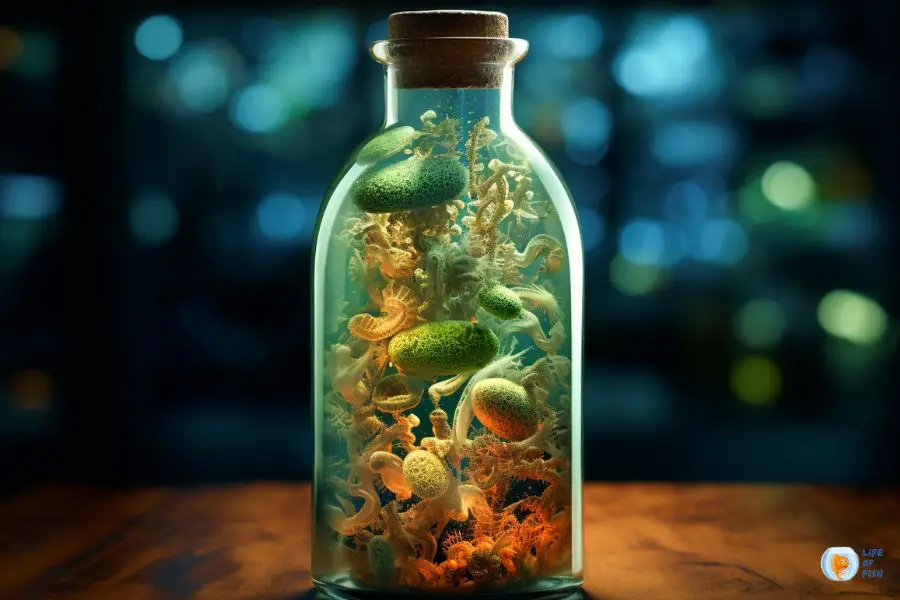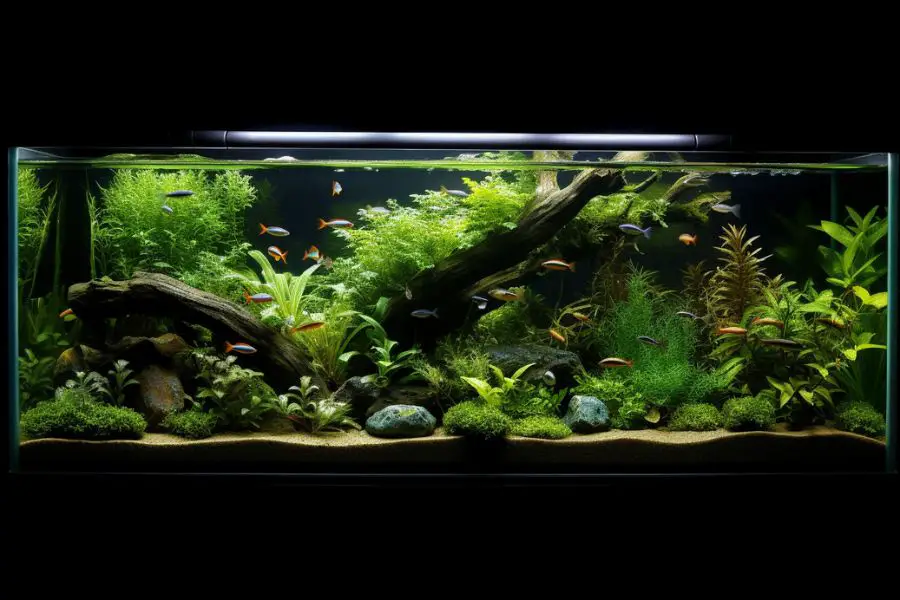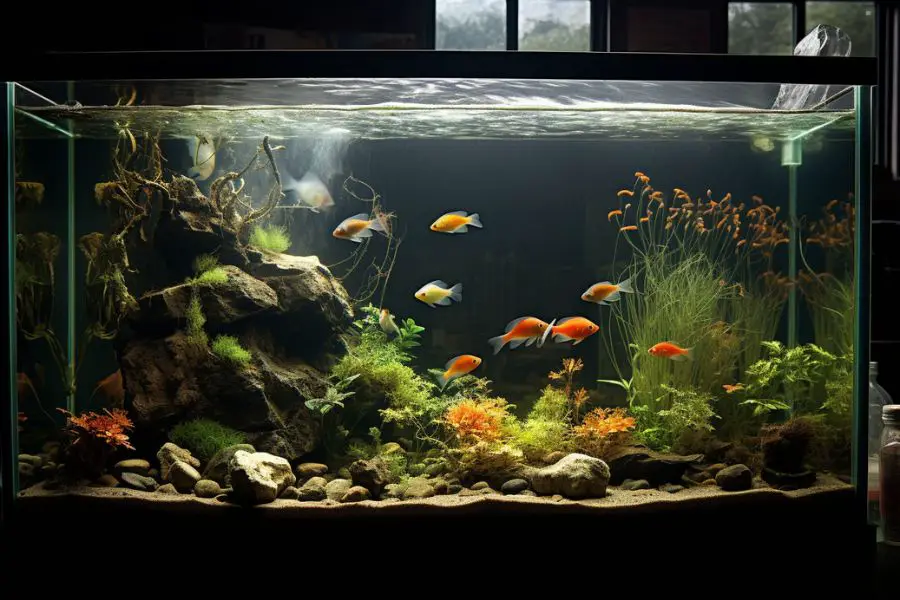Yes, bottled bacteria can help boost your aquarium’s nitrogen cycle by introducing beneficial bacteria that break down ammonia and nitrites. However, their effectiveness depends on various factors such as water conditions, the type of bacteria used, and the overall health of your aquarium ecosystem.

Setting up a new fish tank means waiting out the dreaded nitrogen cycle before adding fish. Bottled bacteria products promise to jumpstart cycling and let you add fish faster. But Do Bottled Bacteria Really Boost Your Aquarium Cycle?
Let’s analyze the science behind the cycle and whether store-bought bacteria actually help establish your aquarium more quickly.
The Biological Balancing Act
Jump To
A key to successful fishkeeping is establishing balanced biological filtration. This means cultivating beneficial bacteria that convert fish waste into less harmful compounds.
In a new tank, two types of bacteria need to populate:
- Nitrosomonas – These oxidize ammonia into nitrite. Ammonia is extremely toxic, so removing it is critical.
- Nitrospira – These convert nitrite into nitrate. Nitrite is also quite toxic to fish.
So the goal is to build colonies of nitrifying bacteria that remove dangerous ammonia and nitrite, allowing nitrate to accumulate instead. Nitrate is much less toxic at low to moderate levels.
Sounds simple enough. But growing robust bacterial colonies takes time. This cycling process usually takes 4-8 weeks in new tanks before they can safely house fish. Bottled bacteria aim to shrink that timeline, but are the claims legit?
A Look Inside Bottled Bacteria Products
These products contain concentrated live bacteria in liquid form. Different brands contain various strains and species tailored to aquarium filtration.
Some common bacterias found in popular supplements include:
- Nitrosomonas europaea – Ammonia oxidizer
- Nitrosomonas eutropha – Ammonia oxidizer
- Nitrosospira – Ammonia oxidizer
- Nitrospira moscoviensis – Nitrite oxidizer
- Nitrobacter winogradskyi – Nitrite oxidizer
These nitrifying bacteria are suspended in a preservative solution to prolong shelf life. The bottles usually need to be refrigerated to maintain bacterial viability.
So in theory, these products provide both major species needed to handle the aquarium nitrogen cycle and kickstart biological filtration. But there are some caveats to consider.

Potential Pitfalls of Bottled Bacteria
While bottled cycling bacteria can provide a head start, there are some important limitations:
Bacteria May Be Dead on Arrival
Even refrigerated, bacteria gradually die off over time. Old product sitting on store shelves for too long may contain mostly dead cells. There’s no easy way to confirm viability.
Specialized Species May Not Adapt
Lab cultured bacteria are isolated strains optimized for cycled environments. Moving them to a new tank with varying conditions can challenge survival.
Results Are Inconsistent
Users report very mixed results, even when following instructions precisely. The unpredictability makes it hard to rely on bottled bacteria alone.
Bacteria Alone Don’t Cycle Tanks
You still need ammonia and substrate surface area for bacteria to colonize. The bottled boost doesn’t eliminate basic cycling requirements.
Risk of New Tank Syndrome
Even with added bacteria, excess ammonia and nitrite from fish stocking too early can overwhelm the fragile biological filtration.
So while bottled cycling bacteria can give a head start, they don’t reliably generate fully cycled tanks fast enough to add many fish right away. Patience and supplemental cycling methods are still needed.
Maximizing Success With Bottled Bacteria
If you want to use bottled bacteria successfully, here are some tips:
- Follow instructions carefully and don’t overdose.
- Check expiration dates and store refrigerated.
- Add to established tanks when changing filters to seed bacteria.
- Introduce during tank startup along with pure ammonia dosing.
- Test parameters daily and add bacteria again if ammonia or nitrite spikes.
- Wait until both reach zero before adding any fish.
- Start with just a few hardy fish for the tank size.
- Maintain optimal conditions like temperature, oxygenation, and low CO2.
- Supplement with filter media from an established tank when possible.
- Have patience. Even with bacteria additives, cycling takes at least 2-4 weeks.
Bottled cycles require a measured approach and reasonable expectations. But they can give your tank biology a helpful boost when used properly!
Alternatives to Bottled Bacteria
If you don’t want to use bottled bacteria supplements, no problem! Here are some other options to kickstart your aquarium cycle:
- Hardscape and Filter Media From Established Tank – Packed with beneficial bacteria ready to colonize
- Pure Ammonia Dosing – Feeds bacteria during fishless cycling
- Raw Shrimp – Decays slowly to provide ammonia
- Seeding Filter Media – Place established media into filters of new tank
- Marine Live Rock – Porous rock brings bacteria to saltwater tanks
- Planted Tanks – Plants readily consume ammonia and nitrite
- Natural Cycling With Hardy Fish – Slowly stock with fish over 6-8 weeks
A little creativity goes a long way when jumpstarting your nitrification cycle. Just be patient and let nature run its course!

The Verdict on Bottled Bacteria
At the end of the day, bottled cycling products can give your aquarium biology a boost but not instant results. They are helpful supplements but not miraculous cure-alls.
Approach bottled bacteria as an ally for your tank’s natural maturation rather than a way to cut corners. Be strategic in dosing and testing to make sure your nitrogen cycle fully establishes.
Most importantly, don’t abandon essential practices like gradual stocking and monitoring water parameters. Healthy aquatic ecosystems emerge in their own time, not on our hasty schedules. Respect the process, and you’ll be rewarded with a thriving aquarium!
READ NEXT:
10 Way How To Raise pH In The Aquarium
